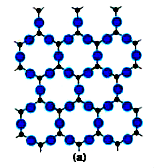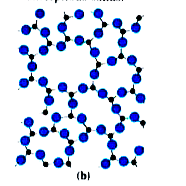Explain crystalline and amorphous solids.
Based on the arrangement of particles, solids are broadly classified as :
(i) Crystalline solids (ii) Amorphous solids
(i) Crystalline Solids : A solid in which the constituent particles have definite ordered arrangements are called crystalline solids.
A crystalline solid consits of a large number of small crystals, each of them having a definite characteristic geometrical shape.

In a crystal, the arrangement of constituent particles (atoms, molecules or ions) is ordered and repetitive in three dimensions. If we observe the pattern in one region of the crystal, we can predict accurately the position of a particles in any other region of a crystal however far they may be from the place of observation.
It has a long range order which means that there is a regular pattern of arrangement of particles which repeats itself periodically over the entire crystal.
Crystalline solids have a sharp melting point and at characteristic temperature they melt abruptly and become liquid.
Crystalline solids are anisotropic. It means in the same crystal, some of their physical properties like electrical resistance or refractive index etc, show different values when measured along different directions. Examples of crystalline solids are sodium chloride, quartz etc.
(ii) Amorphous Solids : The term "Amorphous" is derived from the Greek word "Amorphos" meaning "no form". A solid in which there is irregular arrangement of constituent particles are called amorphous solids.

The arrangement of constituent particles (atoms, molecules or ions) in such a solid has only short range order. Thus a regular and periodically repeating pattern is observed over short distances only. Regular patterns are scattered and in between the arrangement is disordered. Ex. : Glass, Rubber etc.
Amorphous solids soften, melt and start flowing over a range of temperature and can be moulded and blown into various shapes.
Amorphous solids have same structural features as liquids and are conveniently regarded as extremely viscous liquid. They may become crystalline at some temperature. For example, some glass objects from ancient civilisations are found to be milky in appearance because of some crystallisation.
The amorphous solids have a tendency to flow like a liquids though very slowly. Therefore, some time they are referred as "Pseudo Solids" or super cooled liquids. For example, A glass panes fixed to a windows or doors of old buildings are found to be thicker at the bottom than at the top.
Amorphous solids are isotropic in nature. This is due to absence of long range order in them and arrangement of particles is not definite along all directions. Hence, overall arrangement becomes equivalent in all directions. Therefore value of any physical property such as mechanical strength, refractive index & electrical conductivity etc. are same in all directions.
Amorphous silicon is best photovoltaic material for conversion of sunlight to electricity.
Topper's Solved these Questions
- THE SOLID STATEBOOK - KUMAR PRAKASHANCHAPTER - THE SOLID STATEEXERCISE - SECTION - A (EXAMPLES)
5 Videos
- THE SOLID STATEBOOK - KUMAR PRAKASHANCHAPTER - THE SOLID STATEEXERCISE - SECTION - B (INTEXT QUESTIONS AND ANSWERS)
23 Videos
- THE SOLID STATEBOOK - KUMAR PRAKASHANCHAPTER - THE SOLID STATEEXERCISE - SECTION - E (MULTIPLE CHOICE QUESTIONS)(MCQs ASKED IN BOARD EXAMS)
35 Videos
- THE P-BLOCK ELEMENTS BOOK - KUMAR PRAKASHANCHAPTER - THE P-BLOCK ELEMENTS EXERCISE - SECTION-E (MULTIPLE CHOICE QUESTIONS (MCQS)) (MCQS ASKED IN BOARD EXAM)
77 Videos
Similar Questions
Mention three differences between crystalline and amorphous solids.
View SolutionWrite two points of distinction between crystalline and amorphous solids.
View SolutionWrite two points of distinction between crystalline and amorphous solids.
View Solution(a) Define the terms crystalline and amorphous solids.
(b) Explain Schottky defect with an example.
View Solution(a) Define the terms crystalline and amorphous solids.
(b) Explain Schottky defect with an example.
View Solution(a) Define the terms crystalline and amorphous solids.
(b) Explain Schottky defect with an example.
View SolutionDefine Anisotropy, Distinguish between crystalline solids and amorphous solids.
View SolutionWhat is the principle differnece between crystalline and amorphous solids?
Crystalline solidsAmorphous Solids(a) ionic bondingCovalent bonding(b) Higher molar massesLower molar masses(c) Stoichiometric solidsNon-stoichiometric solids(d)Long-range orderLack of long-range order
View SolutionDistinguish between crystalline and amorphous solids in terms of
(a) Cleavage property
(b) Heat of fusion.
View SolutionOut of crystalline and amorphous solids, which can be cleaved easily ?
View Solution
